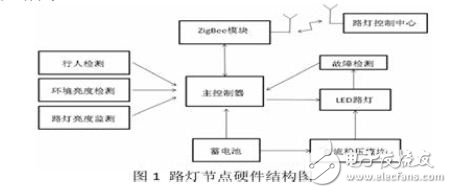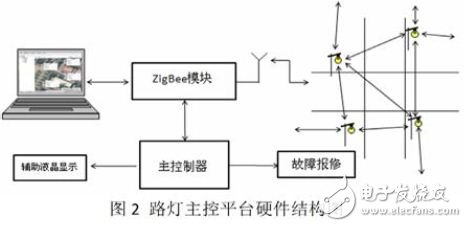The article cooperates with LED street light and multi-channel sensor and IEEE802.15.4 ZigBee wireless ad hoc network technology, can return the status information of each street lamp in real time and detect various street lamp faults, and timely feedback fault information to the server control node through GSM communication module. The centralized control and maintenance of large-scale street lighting system is realized, which greatly reduces the operation and maintenance cost. The street lamp management software of the upper computer is convenient for the management personnel to operate and use.
0 Preface
The urban intelligent LED lighting system is an important part of the intelligent transportation system. The use of intelligent Internet of Things technology can effectively improve how to save energy, improve the utilization of street lamp energy, and automate and intelligently manage street lamps.
ZigBee technology provides a suitable solution for the field of street lamp automatic control with its low power consumption, reliable communication and large network capacity. The LED intelligent lighting control system based on ZigBee self-organizing network combines the advantages of ZigBee in short-distance wireless transmission with the long life of LED lighting and the advantages of energy saving. It is safe, intelligent, easy to control, and easy to maintain.
This paper proposes a traffic lighting control system based on Internet of Things technology. The use of ZigBee technology combined with new sensors, power controllers and LED street lights completes centralized monitoring of urban street lighting systems.
1 system design
For street lamps, the lighting effect is the most important. Other sensors are designed to assist the street lamps to achieve better lighting effects or reduce unnecessary waste of resources. Therefore, the choice of sensors is more critical. The sensors involved in this system include human pyroelectric infrared sensor and tSL2561 brightness sensor. The street lamp node is mainly composed of LED lamps, battery, LED voltage regulator circuit, fault detection circuit, microcontroller, ZigBee wireless data transmission module and other peripheral sensor modules. The overall structure of the system is shown in Figure 1.

There are three working modes of the street lamp of this system: day mode, night mode and midnight mode. The working mode is selected on the main control platform, and the working mode is set by the external environment.
In the normal mode during the day, when the ambient brightness is strong to a certain light intensity value, the street light is no longer needed, and the street light will be turned off. In special cases, such as rainy or foggy weather, it only needs to be set on the main control platform. In order to open the street light, you can deal with various unexpected situations.
In the night mode, the street light will judge according to the set light intensity value. When the ambient brightness is less than the set light intensity, the street light is turned on, and the state of the street light is sent to the main control platform through the wireless data transmission module, in the main control The status of the street light can be observed at any time on the interface of the platform. Once the street light is suddenly turned off, the self-checking function will be implemented, and the repair information will be sent to the main control platform. The main control platform can analyze the data and send the problematic street light information to the street lamp maintenance personnel through the GSM module. On the mobile phone, to achieve timely maintenance of street lights.
In midnight mode, the main control platform will turn off the street lights according to the time of the computer system to save energy. The hardware structure of the main control platform is shown in Figure 2.

2 system hardware design
2.1 Control section
2.1.1 Main controller unit
The main control platform uses LCD12864 liquid crystal to display the real-time status information of the street light. The central processor uses the Arduino MEGA2560 microcontroller to process real-time data information of the street light.
The processor core of MEGA2560 is ATmega2560, with 54 digital input/output ports (16 of which can be used as PWM output), 16 analog inputs, 4 UART interfaces, 16MHz crystal oscillator, compatible with Arduino UNO design. Expansion board. On-chip resources can meet the needs of single-lamp node lighting, and provide a larger choice for subsequent development of new applications on street lamps.
2.1.2 Fault Monitoring
The system uses the external sensor of the street lamp to control the state of the street lamp with the microcontroller, so the monitoring of the street lamp failure is more complicated. To achieve remote fault monitoring, a wireless module that works normally is required. If the data returned by the wireless module cannot be monitored, the problem may occur in power supply or module damage.
The calculation formula is: checkDATA = 0xFF - (type) - (DATA)
When the street light fails, similar data is sent to the master platform:

The main control platform calculates the received data, sums the values ​​of the last three bytes of the received frame data, and makes a judgment. If it is 0xFF, the frame data is valid; otherwise, the frame data is invalid. The simpleness of calculation and judgment can be used to know the correctness of information sources and information data as well as information. This can greatly improve the reliability and stability of the data.
2.1.3 Troubleshooting
This system uses Huawei's GTM900C wireless communication module to feedback fault information. This is a two-band GSM/GPRS wireless module that supports standard AT commands and enhanced AT commands. It provides rich voice and data services, and supports Text and SMS (Short Message Service) in PDU format can communicate with the microcontroller through the UART interface.
The street light manager can know the current street light status through the LCD screen. If the street lamp fails, the microcontroller will analyze the feedback information, display the faulty street light information on the LCD screen, and send a text message to the specified mobile phone number to inform the fault street light information. Street lamp maintenance personnel can know the cause of street lamp failure by SMS, which will reduce maintenance time and improve maintenance efficiency.
Hepa Fliter Vacuum Cleaner,Filter Vacuum Cleaner,Multifunction Robot,Cleaner Automatic
NingBo CaiNiao Intelligent Technology Co., LTD , https://www.intelligentnewbot.com